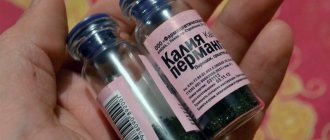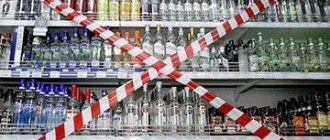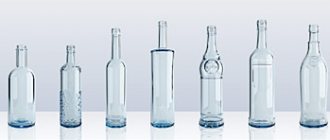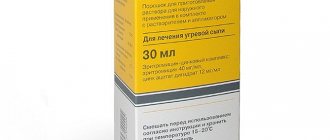Subject-quantitative accounting of ethyl alcohol in a medical organization
Topic : Circulation of medicines Source: Electronic system “Control in health care facilities”
Ethyl alcohol does not belong to NS and PI and is included in section II of the “List of medicines for medical use subject to subject-quantitative accounting” approved by Order of the Ministry of Health of the Russian Federation dated April 22, 2014 No. 183n.
Accordingly, it is not subject to the requirements of Decree of the Government of the Russian Federation No. 1148 on the storage of NS and PV and the rationing of stock in departments (in days).
Until now, the circulation of ethyl alcohol in medical organizations (hereinafter - MO) is regulated by Order of the USSR Ministry of Health dated August 30, 1991 No. 245 “On standards for the consumption of ethyl alcohol for healthcare, education and social security institutions” (hereinafter - Order No. 245), some the provisions of which no longer correspond to the realities of today.
So, clause 1.6. Order No. 245 indicates that “The supply of ethyl alcohol to healthcare institutions is carried out on the basis of requirements signed by the head of the institution (department) and certified by the seal of the institution under a separate power of attorney, executed in the prescribed manner and giving the right to receive alcohol within one month. Alcohol is sold by weight at the price established for medical institutions.”
However, over the past 10 years, ethyl alcohol has not been supplied to the Moscow Region by total weight; issuing it to departments and posts in weight measurement has become impossible. Pharmacopoeial ethyl alcohol for the needs of Moscow Region is supplied in 100 ml bottles in various concentrations.
In the departments of the Moscow Region, the head nurse dispenses ethyl alcohol to posts, operating rooms, dressing rooms, etc. in the number of bottles required to perform certain manipulations (processing parts of medical equipment, hands, etc.) usually per day (in order to prevent non-medical use).
Thus, accounting for the movement (income and consumption) of ethyl alcohol both in the pharmacy and in the departments of the Ministry of Defense when issued to posts and other units is carried out by the number of bottles.
From the Moscow Pharmacy, ethyl alcohol is dispensed in bottles based on the requirements of the departments and is written off as an expense based on the number of bottles dispensed.
In the Moscow Region, recording of the movement of ethyl alcohol should be carried out in accordance with the order of the Ministry of Health of Russia dated June 17, 2013 No. 378n “On approval of the rules for registering transactions related to the circulation of medicines for medical use, included in the list of medicines for medical use, subject to subject-quantitative accounting , in special logbooks for transactions related to the circulation of medicines for medical use, and rules for maintaining and storing special logbooks for transactions related to the circulation of medicines for medical use” (hereinafter referred to as Order No. 378).
In municipalities that have a pharmacy, ethyl alcohol is recorded:
- in the pharmacy of the Moscow Region - in the Logbook of transactions related to the circulation of medicines for medical use (Appendix No. 2 to Order No. 378n);
- in departments of the Moscow Region - in the Logbook of transactions related to the circulation of medicines for medical use (Appendix No. 3 to Order No. 378n).
In municipalities that do not have pharmacies - also in the Logbook of transactions related to the circulation of medicines for medical use (Appendix No. 3 to Order No. 378n);
In each form of the Journal, a separate sheet (or several sheets depending on the frequency of operations performed) is created for ethyl alcohol, indicating the name of the drug, dosage (40, 70, 90, 95% - 100 ml), dosage form (solution), unit of measurement (bottle ).
Attention ! A separate sheet is prepared for each concentration of ethyl alcohol.
93.79.221.197 © studopedia.ru Not the author of the materials posted. But it provides the opportunity to use it for free. Is there a copyright violation? Write to us | Feedback.
Disable adBlock! and refresh the page (F5)
very necessary
Many chemical reagents used in laboratory practice contain ethyl alcohol. The circulation of ethyl alcohol in our country is regulated by the Federal Law “On state regulation of the production and circulation of ethyl alcohol, alcoholic and alcohol-containing products and on limiting the consumption (drinking) of alcoholic products” dated November 22, 1995 No. 171-FZ.
In general, this entire Law cannot be applied to the circulation of chemical reagents and other alcohol-containing medical products, therefore the above-mentioned law provides that the Government of the Russian Federation can create lists of products, including medical products, containing ethyl alcohol, which are not covered by its action.
The rules for creating a list of alcohol-containing medical products, the production, production and circulation of which are not covered by Federal Law No. 171-FZ of November 22, 1995, were approved by Government Resolution No. 774 of June 15, 2019.
This resolution entrusts the Federal Service for Surveillance in Healthcare with the right to form a Commission for the formation of a list of alcohol-containing medical products, the production, manufacturing and (or) circulation of which is not covered by the Federal Law “On State Regulation of the Production and Trade of Ethyl Alcohol, Alcoholic and alcohol-containing products and on limiting the consumption (drinking) of alcoholic products” and approve the composition of this commission in accordance with the developed Regulations.
Alcohol-containing medical products in liquid form registered in the Russian Federation are subject to inclusion in the list provided they meet one or more of the following criteria:
a) the volume of consumer packaging (packaging) of a medical product (regardless of the volume fraction of the pharmaceutical substance contained in it, ethyl alcohol (ethanol) or ethyl alcohol) does not allow its use as a substitute (surrogate) for alcoholic products;
b) the retail price of a medical product, when compared in comparable volumes for consumer packaging (packaging) and ethyl alcohol content, is 20 percent or more higher than the retail price for alcoholic products with a strength of over 28 percent, established in accordance with paragraph two of Article 5 of the Federal Law “On State regulating the production and circulation of ethyl alcohol, alcoholic and alcohol-containing products and limiting the consumption (drinking) of alcoholic products”;
c) the functional purpose (intended use) of the medical device, established by the manufacturer (manufacturer) in the operational documentation (instructions for use), is not related to the use of the medical device inside the human body or does not allow its use as a substitute (surrogate) for alcoholic products.
To include a medical device in the list (exclusion from the list), the applicant submits a proposal to the Federal Service for Surveillance in Healthcare with the attachment of the documents listed in the Resolution.
Proposals are considered at a meeting of the Roszdravnadzor Commission, decisions are posted on the website and sent to the Ministry of Health of the Russian Federation, which in turn sends the list to the Government of the Russian Federation for approval.
The document forms required to include a medical device in the list of alcohol-containing medical devices and the decisions of the commission on the formation of the list are published on the Roszdravnadzor website in the medical devices section.
Accounting and storage of alcohol in medical institutions
The procedure for dispensing alcohol from pharmacies is established by Order No. 785, according to Appendix No. 1 to which ethyl alcohol
refers to medicinal products subject to subject-quantitative accounting in pharmacies, drug wholesale trade organizations, medical institutions and private practitioners. We note that the procedure for recording medicines that are subject to subject-quantitative accounting is not established by current legislation. Internal control of pharmacy employees’ compliance with the procedure for dispensing medicines subject to subject-quantitative accounting is carried out by the head (deputy head) of the pharmacy or a pharmaceutical worker authorized by him (clause 4.1 of Order No. 785). Consequently, ethyl alcohol must be recorded in a journal in a form approved by an internal order of the head of the institution. For pharmacies, Order No. 14 is currently in force, which establishes the AP-10 form “Logbook of poisonous, narcotic, other medicines and ethyl alcohol.” Medical institutions can also use this form for subject-quantitative accounting of alcohol or develop their own version based on it. Order No. 14 approved recommendations for filling out the AP-10 log. The magazine is open for a year. For each packaging, dosage and name of medicines, a separate sheet (spread) is provided. The receipt is reflected in the journal for each receipt document separately, indicating the number and date. Consumption is recorded as daily totals, subdivided into dispensing for outpatient prescriptions and dispensing to medical institutions, pharmacy points and departments of pharmacies and stores. The journal is filled out by the head of the pharmacy (department), the foreman or their deputies. In the column “Actual balances” the signature of the person who checked the presence of valuables is also placed. For medical institutions, in addition, it is advisable to keep records separately for each packaging and dosage, reflecting receipts for each document, and expenses - in daily totals. Filling out the log is usually assigned to the chief or senior nurse, who check the actual availability of valuables at the end of the day. We also note that the basis document allowing pharmacies to dispense alcohol to medical institutions is a license for medical activities (clause
Accounting procedure
In the Moscow Region, records of the movement of ethyl alcohol should be kept in accordance with the order of the Ministry of Health of Russia dated June 17, 2013 No. 378n “On approval of the rules for registering operations related to the circulation of medicines for medical use, included in the list of medicines for medical use, subject to subject-specific quantitative accounting, in special logbooks for transactions related to the circulation of medicines for medical use, and rules for maintaining and storing special logbooks for transactions related to the circulation of medicines for medical use” (hereinafter referred to as Order No. 378).
☆ Ethanol Logbook. Template in the Chief Nurse System
Download the document now
In municipalities that have a pharmacy, ethyl alcohol is recorded:
- in the pharmacy of the Moscow Region - in the Logbook of transactions related to the circulation of medicines for medical use (Appendix No. 2 to Order No. 378n);
- in departments of the Moscow Region - in the Logbook of transactions related to the circulation of medicines for medical use (Appendix No. 3 to Order No. 378n).
- In municipalities that do not have pharmacies - also in the Logbook of transactions related to the circulation of medicines for medical use (Appendix No. 3 to Order No. 378n);
In each form of the Journal, a separate sheet (or several sheets depending on the frequency of operations performed) is created for ethyl alcohol, indicating the name of the drug, dosage (40, 70, 90, 95% - 100 ml), dosage form (solution), unit of measurement ( bottle).
You will have time to download everything you need using demo access in 3 days
?
Container, packaging and completeness of medicines
No longer in force on 12/31/2020: Order of the Ministry of Health of the Russian Federation dated December 21, 2021 N 979n “On approval of requirements for container volume, packaging and completeness of medicinal products for medical use.”
Entered into force: Order of the Ministry of Health of Russia dated July 31, 2020 N 779n “On approval of requirements for container volume, packaging and completeness of medicinal products for medical use.”
Comment: The production of drugs intended for internal use, as well as their sale and transfer, is carried out by drug manufacturers in containers containing the volume of the drug:
- no more than 25 ml with a volume fraction of alcohol over 50% and a course dose of drugs no more than 75 ml inclusive; - no more than 50 ml with a volume fraction of alcohol from 30% to 50% and a course dose of drugs not more than 100 ml inclusive; - no more than 100 ml with a volume fraction of alcohol up to 30% and a course dose of drugs not exceeding 200 ml inclusive.
The concentration of alcohol included in the medicinal product is indicated on the primary and secondary (if any) packaging. Manufacturers, when selling and transferring drugs, complete them in accordance with the instructions for medical use of the drug.
No longer in force on 12/31/2020: Order of the Ministry of Health of the Russian Federation dated February 8, 2021 N 47n “On approval of the list of medicinal products for medical use, for which requirements for container volume, packaging and completeness are established.”
Entered into force: Order of the Ministry of Health of Russia dated July 31, 2020 N 778n “On approval of the list of medicinal products for medical use, for which requirements for container volume, packaging and completeness are established.”
Comment: A list of alcohol-containing tinctures, drops, extracts and elixirs has been approved, in respect of which the requirements of Order 779n are established.
The use of ethyl alcohol in medicine
Ethyl alcohol belongs to the category of medicines that are subject to special registration.
Due to the spread of other antiseptics and innovative technologies, today we can observe a trend towards reducing the use of alcohol in medicine.
Despite this, as long as alcohol continues to be used in a medical institution, even in small quantities, the head physician is responsible for the validity of its issuance to health workers, the rationality of the use of the substance, as well as for compliance with the rules for its accounting and storage.
We will tell you how to take into account the need and consumption of ethyl alcohol, the procedure for its dispensing and storage.
How to calculate the need for ethyl alcohol
For each department of a medical organization, the need for the supply of ethyl alcohol is calculated separately. This takes into account what manipulations are carried out in the department, what methods of therapy are used and what equipment is needed for this.
Next, the total amount of alcohol that entered the organization is distributed between departments.
The responsible employee of the department receives ethyl alcohol on the basis of a demand invoice, which is signed by the head physician and certified by the seal of the organization. To obtain a standard, a power of attorney executed in the prescribed manner is required. It gives the right to receive alcohol for 30 days.
In private clinics, the intersectoral invoice form M-11 is used for this; public sector employees use form 0504204.
Destruction of drugs
Expired 12/31/2020:
1. Decree of the Government of the Russian Federation of September 3, 2010 N 674 “On approval of the Rules for the destruction of substandard medicines, counterfeit medicines and counterfeit medicines”
2. Decree of the Government of the Russian Federation of January 16, 2016 No. 8 “On amendments to the Rules for the destruction of substandard medicines, counterfeit medicines and counterfeit medicines”
The following came into force: Decree of the Government of the Russian Federation of September 15, 2020 N 1447 “On approval of the Rules for the destruction of seized counterfeit medicines, substandard medicines and counterfeit medicines.”
Comment: According to the Resolution, when an authorized body makes a decision on the seizure and destruction of counterfeit drugs and (or) substandard drugs, the owner of such drugs is obliged to:
✔remove these drugs from circulation, isolate and place them in a specially designated room (zone) or report disagreement with the specified decision to the authorized body within 30 days from the date of the decision; ✔destroy the seized drugs within 6 months from the date of the decision.
The destruction of falsified, substandard medicinal and counterfeit drugs is carried out by an organization that has a license to carry out activities for the collection, transportation, processing, disposal, neutralization, and disposal of waste of I-IV hazard classes.
The owner of substandard drugs or the organization carrying out the destruction draws up a destruction act, which indicates:
- date and place of destruction of the drug; - full name of the persons who took part in the destruction, place of work and position; - justification for the destruction of the drug; - information about the destroyed drugs (name, dosage form, dosage, units of measurement, series) and their quantity, as well as about the container or packaging; - name of the drug manufacturer; - information about the owner of the drug; - method of destruction of the drug.
The act of destruction is drawn up on the day of destruction of the drug. The number of copies of the act is determined by the number of parties involved in the destruction of the drug. The act is signed by all persons who took part in the destruction of the drug and is certified by the seal of the organization that carried out the destruction. A copy of the act of destruction of medicines, certified in the prescribed manner, is submitted within 5 working days from the date of its preparation or within 5 working days from the date of its receipt by the owner of the destroyed medicines to the authorized body using electronic means of communication.
Dispensing ethanol in a pharmacy
In pharmacies, ethyl alcohol is dispensed in several forms:
- in the form of aseptic solutions of ethyl alcohol 70% and 95%, which are packaged in 100 ml;
- pharmacopoeial ethanol 70% and 95%, which is supplied in factory containers of 21.5 liters and 100 ml.
Ethanol in volumes of 21.5 liters is usually ordered by pathology bureaus and departments, as well as for processing medical equipment and equipment.
In this case, ethanol is released into the departments strictly by weight, in grams, and not in milliliters.
Drug quality
Expired 12/31/2020:
- Order of the Ministry of Health of the Russian Federation dated July 16, 1997 N 214 “On quality control of medicines manufactured in pharmacy organizations (pharmacies).”
- Order of the Ministry of Health of the Russian Federation of October 16, 1997 N 305 “On the norms of deviations permissible in the manufacture of medicines and packaging of industrial products in pharmacies.”
- Order of the Ministry of Health of the Russian Federation of October 21, 1997 N 308 “On approval of the Instructions for the manufacture of liquid dosage forms in pharmacies.”
4.Order of the Ministry of Health of the Russian Federation dated July 20, 2001 N 284 “On approval of norms for the natural loss of medicines and medical products in pharmacy organizations, regardless of the legal form and form of ownership.”
Continues to be in force: In 2021, Order of the Ministry of Health of Russia dated October 26, 2015 N 751n, already familiar to all pharmacy workers, continues to be in effect “On approval of the rules for the manufacture and dispensing of medicinal products for medical use by pharmacy organizations and individual entrepreneurs holding a license for pharmaceutical activities”
Comment: When Order 751n was published, it did not cancel orders 214, 305, 308 and 284, which led to duplication and discrepancies. This defect has now been eliminated.
Order 751n contains not only the rules for the manufacture of different types of dosage forms and types of control, but also all the necessary information used in the manufacture of medicines in industrial pharmacies.
How to keep track of ethanol
Not all chief doctors know how to properly keep records of ethyl alcohol. All expenditure transactions with this drug must be recorded in a special journal, Form No. 3.
When alcohol is distributed to departments, approximate costs of this substance in grams are used, based on its costs for specific interventions. Alcohol, which is packaged in 21.5 liter containers, is written off in grams in each compartment.
Departments of medical institutions and pharmacies usually keep records of alcohol by bottle, as this is a more convenient option for calculating expenses and balances. A batch of ethanol is stored in the pharmacy of medical institutions, which is dispensed to departments on the basis of invoice requirements. Dispensed bottles are written off as expenses.
Today, many healthcare institutions purchase ethyl alcohol in 100 ml bottles, which is due to the convenience of recording its consumption. How to keep records of alcohol consumption in each department is reflected in the local act of the organization, approved by order of the chief physician.
A separate page is created in the registration log for ethyl sports. It states:
- name of the drug;
- the form of its release;
- dosage form - solution, etc.;
- units of measurement (for example, in bottles);
- concentration (percentage of ethanol concentration in solution).
In addition, each dosage of the drug is recorded on separate pages.
In some departments, for example, in dressing rooms, treatment rooms, operating departments, the consumption of ethyl alcohol is calculated according to the actual consumption within 24 hours, based on the method of its use.
In inpatient units, the head nurse is responsible for recording alcohol. She gives alcohol to nurses in bottles, taking into account the amount required to perform work operations - processing medical equipment and equipment, staff hands, injection sites, etc.
As the bottles are used up, the alcohol is written off at the nursing stations, indicating the number of bottles that have ended.
You will have time to download everything you need using demo access in 3 days
?
Storing ethyl alcohol: rules
Ethyl alcohol is one of the dangerous substances that can ignite.
To ensure that it does not cause damage to the medical institution, as well as the health of patients and staff, it is necessary to follow the rules for its storage:
- ethanol must be stored separately from other medications;
- alcohol is stored in a durable plastic or glass container;
- the substance is closed with a stopper or a tight-fitting lid to prevent evaporation of the product;
- Do not store alcohol near heating appliances. This is a gross violation of safety regulations. It is necessary to maintain a distance of at least a meter from the place where alcohol is stored to the batteries.
In addition, since alcohol is a volatile drug, after evaporation it may lose its disinfectant and beneficial properties.
Alcohol for emergency prevention should be stored in a metal cabinet with precautions for access by unauthorized persons.
In any case, when handling ethyl alcohol, it is necessary to comply with the rules for storing medicines, approved by order of the Ministry of Health and Social Development of the Russian Federation No. 706n dated August 23, 2010.
Thus, according to the rules, essential extracts and alcohol tinctures must be stored separately from other drugs and preparations.
Roszdravnadzor checklist - storage of drugs in medical institutions
Look at the checklist in the Chief Nurse System, which is used to check the storage of medications in a medical organization.
The checklist consists of 62 questions and is approved by Appendix 2 to Order No. 9438. Inspectors will evaluate the quality assurance system for storing drugs, premises, equipment and documentation.
Does alcohol belong to NS and PV?
Ethyl alcohol is subject to subject-quantitative accounting, but is not classified as narcotic and psychotropic drugs, that is, it is not included in lists 2 and 3 of such drugs. These lists are approved by the Government of the Russian Federation.
Therefore, alcohol must be stored in metal cabinets in a dedicated room. At the end of the working day, access to the premises is limited by sealing or sealing the door.
Temperature
Ethyl alcohol can be stored at a temperature not exceeding 12-15C. This corresponds to the temperature regime of a conventional refrigerator in which alcohol is placed.
It is necessary to maintain the temperature so that ethyl alcohol does not evaporate during storage.
Substances with which alcohol should not be stored
Substances with which ethyl alcohol must not be stored include:
- compressed and liquid gases;
- inorganic acids – nitric, hydrochloric, sulfuric;
- flammable substances and materials, for example, sulfur, bandages, vegetable oils, etc.;
- inorganic compounds that, when interacting with organic substances, can form mixtures that can ignite (potassium chlorate, chromate or permanganate);
- alkaline compounds.
Safety precautions when using alcohol
The head of the medical organization must approve the algorithm of actions of employees in order to prevent the occurrence of an emergency. To do this, the following work is carried out:
- Determine in which departments and for which procedures you plan to use ethyl alcohol.
- Approve the algorithm for calculating the need for alcohol for different departments.
- Develop a procedure for accounting for ethyl alcohol based on the packaging in which it arrives at the medical organization (in grams or in bottles).
- Conduct internal audits - at certain intervals, check how responsible persons keep records of the receipt and consumption of ethanol.










